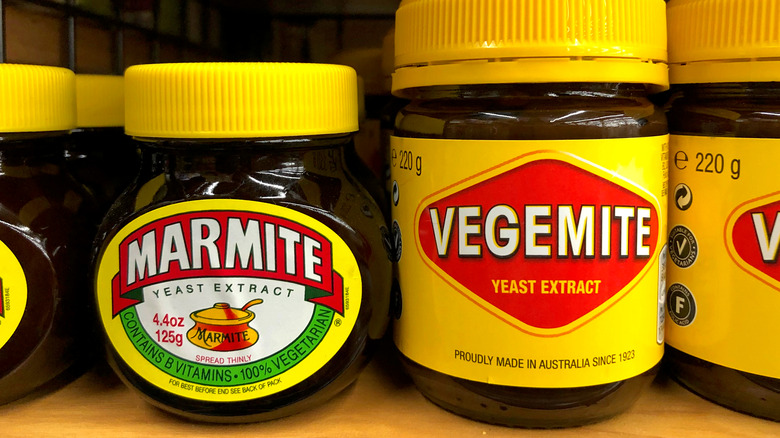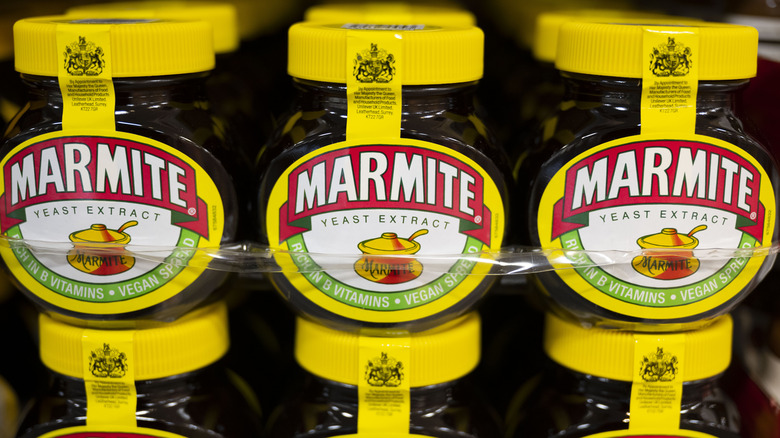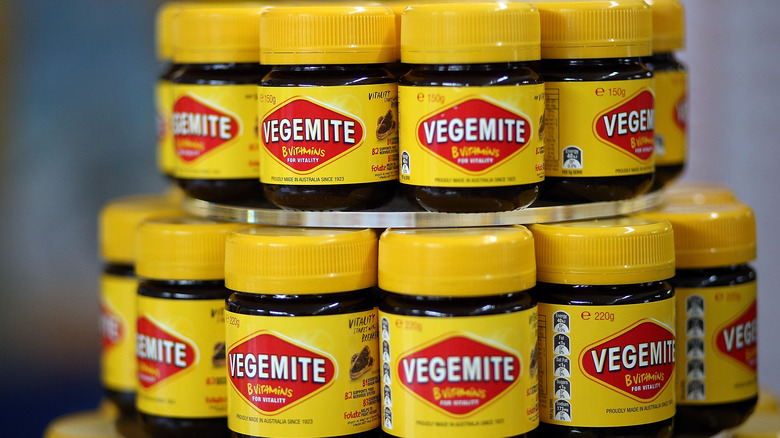Is There A Real Difference Between Marmite And Vegemite?
To the untrained eye (or palate), Marmite and Vegemite might seem interchangeable. After all, they're both dark spreads made from brewer's yeast extract that lends a savory umami flavor, meaning both work well as a soy sauce substitute. You can find both in their signature yellow-lidded glass jars with labels of red and yellow. And for anyone who hasn't grown up eating it, both are extremely salty and pungent — to the point of being polarizing.
But as stalwart supporters of either spread will tell you, one is not like the other. To start, they look different. Marmite has a burnt brown color and a sticky consistency similar to syrup or molasses. Vegemite, on the other hand, is a black paste that's thick like peanut butter. There's a difference in taste, too. While both are salty and savory, Spoon University describes Vegemite as having a hint of bitterness as well. Culture Trip adds that Vegemite is more intense than Marmite, which has slight sweetness and milder flavor in comparison.
What's more, though the ingredient list for each spread has similarities, there are notable differences as well. Marmite's main ingredients are glutamic acid-rich yeast extract, salt, vegetable and spice extracts, and celery extracts, as per Delish, and includes fortified nutrients such as vitamin B12, riboflavin, and folic acid, according to Allrecipes. Vegemite includes salt, vegetable extract, and B vitamins but also malt extract from barley.
How Marmite was invented
Marmite and Vegemite have a difference in origins as well. Though it's beloved in the UK, Marmite was actually invented by German scientist Justus Von Liebig, who discovered that after brewing beer, the leftover yeast could be used to make a thick, gooey and high-protein byproduct (via Kitchn). The production method for the spread involves breaking down the yeast so soluble amino acids and proteins are released. This soluble substance is concentrated and filtered a few times, and then undergoes a special flavor development process that's kept a proprietary secret.
Per the Marmite Museum, this edible invention was first sold in 1902 by the Marmite Food Company, then located in Burton-on-Trent, in Staffordshire, England. It was originally packaged in a small earthenware pot, akin to a type of French casserole vessel called a "Marmite," which served to be the inspiration for the spread's name. That's also why you see a Marmite dish on the product label, even to this day.
It wasn't until 1912 that Marmite hit staple status when the research and work from both English biochemist Sir Frederick Gowland Hopkins and Polish American biochemist Casimir Funk posited that a dietary deficiency of certain vitamins might be the actual cause of certain diseases, according to the Museum of Brands. The spread, packed with B vitamins, became a common source of nutrition in not only schools and hospitals but also for soldiers and prisoners of war during both World Wars.
How Vegemite was invented
Vegemite, however, was created later in 1923 by Australian chemist Cyril Callister from the Fred Walker Company, per the brand's website. But before the spread was officially released, the company launched a national competition, inviting Australians far and wide to name the new product. After going through hundreds of entries, "Vegemite" was selected as the winning moniker by Fred Walker's daughter. The spread was then sold in grocery stores throughout Australia under that name.
However, by that time, Marmite, which had been invented earlier, had made its way over to Australia and was far more popular, so Aussies were hesitant to try Vegemite and sales of the spread did not fare well. Determined to make his product successful, Walker rebranded it to "Parwill" in 1928, but this failed to improve its popularity.
Eventually, the spread took on the Vegemite name again and was promoted with a limerick competition for prizes such as Pontiac cars in 1937. Entries flooded in and Vegemite sales increased nationwide. Following this positive response came an official endorsement from the British Medical Association in 1939. The brand also started advertising in the British Medical Journal. Meanwhile, medical and childcare professionals were recommending Vegemite as a nutritious food rich in B vitamins.
Because of its health halo, the Australian armed forces were even buying the spread in bulk by World War II, when Vegemite truly took off. Though, according to the National Museum of Australia, this surge was actually due to a shortage of Marmite, which made Vegemite a natural substitute at the time. All of this, however, culminated in Vegemite rising to become a staple in Australian households.
How to eat Marmite and Vegemite
Brits and Aussies alike commonly enjoy Marmite or Vegemite lightly scraped on buttered toast. Neither spread should be slathered on heavily — a rookie mistake — but a touch of either one can be used to add saltiness to certain dishes. In fact, you'd be surprised how Nigella Lawson uses Marmite.
In the UK, Marmite is sometimes added to hot water to make a hot drink or to cheese sandwiches. In Australia, there are treats like the cheesymite scroll, a spiral of bread with Vegemite and cheese baked inside, or Vegemite on toast with smashed avocado (via Culture Trip).
The two spreads are sold in their regular forms, as well as in reduced-salt and squeezable versions, but Marmite is also sold as a crunchy peanut butter and Marmite XO (extra old), a version that's matured for four times longer than regular Marmite. In contrast, the Vegemite product range includes a gluten-free version and Vegemite and Cheese, made with cream cheese.
However you want to eat them, it's clear that while Marmite and Vegemite could be considered cousins, the two are not the same.



